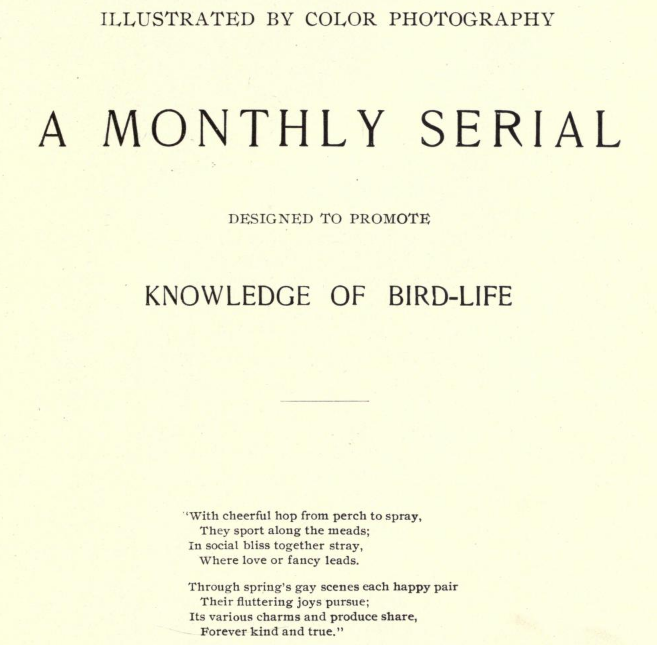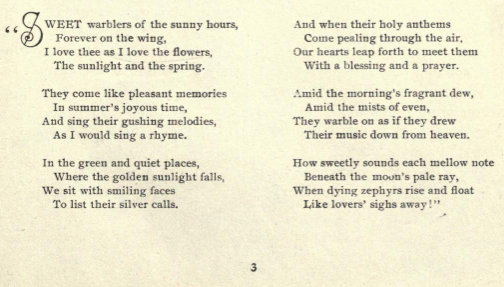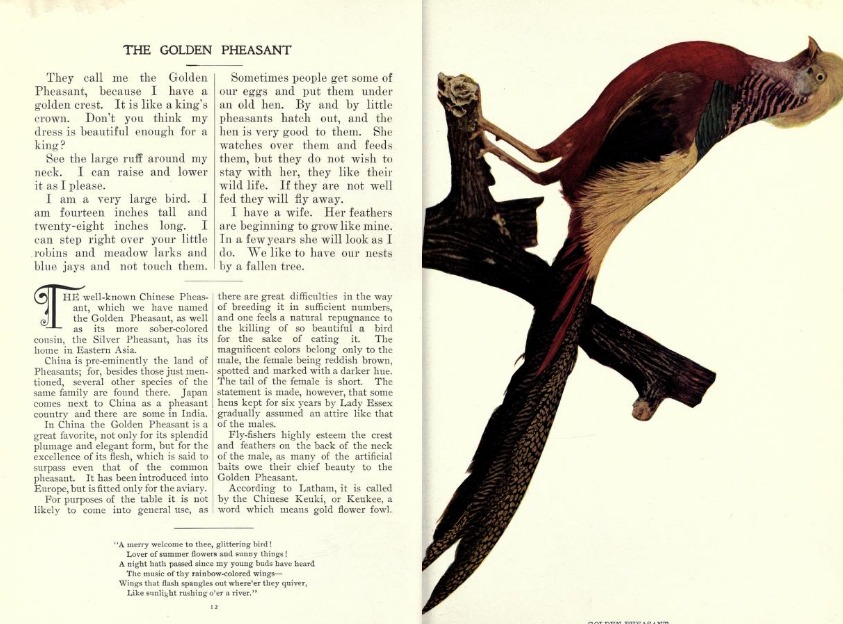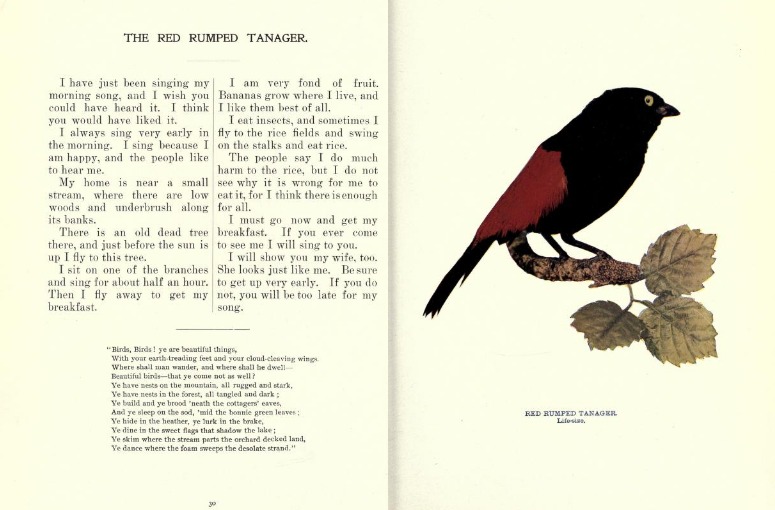In this post, I conclude covering all of the content from the January 1897 issue of Birds: A Monthly Serial, or Birds: Illustrated By Color Photography, with an article covering several bird poems from the issue. While writing about each of the ten birds featured in the magazine, I decided to hold off on the poems for a capstone article. In addition to covering the poems, I will revisit the birds from the article that received dedicated poems, along with posting links to my articles about each.
You can follow along with the bird poem content with the original 1897 magazine on Project Gutenberg and The Internet Archive.
I. Title Poem
The title page of the January 1897 issue of Birds: Illustrated By Color Photography, came with a poem generally applicable to many birds. The poem, reprinted below, reads as follows:
"With cheerful hop from perch to spray
They sport along the meads;
In social bliss together stray,
Where love or fancy leads.
Through spring's gay scenes each happy pair
Their fluttering joys pursue;
Its various charms and produce share,
Forever kind and true.
If only all the birds were as cheery as this poem suggests. As we discovered, the magazine occasionally took some dark paths.

II. The Nonpariel Poem

The very first bird in the issue, the Nonpariel, received the first article-specific poem. Given how splendid some of the subsequent birds were in the issue, I am reluctant to say that the Nonpariel was beyond compare. It nevertheless perched itself on a high bar, and stands no worse than feather to feather with its avian competition. If there is one area that it had no rival, it was in the confidence of its own self-introduction, tempered only by the fact that it was kept in a cage when it preferred to be out in the wild.
"Sweet warblers of the sunny hours,
Forever on the wing,
I love thee as I love the flowers,
The sunlight and the spring.
They come like pleasant memories
In summer's joyous time,
And sing their gushing melodies,
As I would sing a rhyme.
In the green and quiet places,
Where the golden sunlight falls,
We sit with smiling faces
To list their silver calls.
And when their holy anthems
Come pealing through the air,
Our hearts leap forth to meet them
With a blessing and a prayer.
Amid the morning's flagrant dew,
Amid the mists of even,
They warble on as if they drew
Their music down from heaven.
How sweetly sounds each mellow note
Beneath the moon's pale ray,
When dying zephyrs rise and float
Like lovers' sighs away!"
The end of the first stanza is timely as we sit at the time of this writing on the precipice of spring: “I love thee as I love the flowers / The sunlight and the spring.” Some lucky people who live in the right places will be able to usher in the spring with Nonpariel songs.
III. The Golden Pheasant Poem

At the time of publication, the Golden Pheasant’s article is the most-read of all of our articles from Birds. That should come as minor solace to our friend with the best head of feathery hair after the original Birds article spent a good amount of time fixating on people eating Golden Pheasants. Perhaps to make up for the somewhat unfortunate start of the Golden Pheasant article in the original, the editors saw fit to give the pretty Pheasant a lovely poem. We reprint the poem below:
"A merry welcome to thee, glittering bird!
Lover of summer flowers and sunny things!
A night hath passed since my young buds have heard
The music of thy rainbow-colored wings--
Wings that flash spangles out where'er they quiver,
Like sunlight rushing o'er the river."
This poem does a fine job of describing the appearance of the Golden Pheasant. He is indeed a “glittering bird” – especially his head – and he does in fact have “rainbow-colored wings.”
IV. The Red Bird of Paradise Poem

Several of the bird articles contained third-party passages from naturalists, scientists, and unnamed individuals. No bird had finer content included about it than the Red Bird of Paradise – the passage about it by the unnamed traveler from Guinea was the finest piece of writing in the magazine. Below, you will find part of that passage reprinted:
They seem the inhabitants of a fairer world than ours, things that have wandered in some way from their home, and found the earth to show us something of the beauty of worlds beyond.
A traveler in Guinea describing the Red Bird of Paradise
It seems unfair that the Red Bird of Paradise also earned an original poem, but that it did. The Red Bird of Paradise poetry is not quite as memorable as the prose, but it is good nonetheless:
"Upon its waving ffeathers poised in air, Feathers, or rather clouds of golden down, With streamers thrown luxuriantly out In all the wantonness of winged wealth."
The Red Bird of Paradise certainly received a wealth of interesting passages in its brief article.
V. The Red-Rumped Tanager Poem

The penultimate bird, the Red-Rumped Tanager, was the subject of an investigative article due to the fact that the name “Red-Rumped Tanager” is no longer used to describe it. The original article was unique among the bird pieces in how it used the Red-Rumped Tanager’s self-introduction to summarize the information contained in a long account by the esteemed nineteenth-century naturalist, George K. Cherrie, about the bird. The Red-Rumped Tanager also received a poem, which more than any of the previous poems, is a celebration of bird life:
"Birds, Birds! ye are beautiful things, With your earth-treading feet and your cloud-cleaving wings. Where shall man wander, and where shall he dwell-- Beautiful birds--that ye come not as well? Ye have nests on the mountain, all rugged and stark, Ye have nests in the forest, all tangled and dark; Ye build and ye brood 'neath the cottagers; eaves, And ye sleep on the sod, 'mid the bonnie green leaves; Ye hide in the heather, ye lurk in the brake, Ye dine in the sweet flags that shadow the lake; Ye skim where the stream parts the orchard decked land, Ye dance where the foam sweeps the desolate strand."
Bringing this Bird Journey to a Close
With this brief poetic conclusion, we have covered all of the content in the inaugural issue of Birds: Illustrated By Color Photography. It has been an interesting project both in studying the original 1897 magazine and in finding up-to-date sources on the featured birds. I may add bonus articles to the series in the future to expand on points that were not fully explored in the original posts.
You will find all series entries in our archive.